Safety notes and important information
Keep the emitter clean; wipe off dust with a dry cloth. Never use cleaning agents, solvents or chemicals. Never press any object onto the optics hole.
Regularly check the battery inside the simulator body for corrosion or leaks.
If you will not be using the simulator for more than a week, you must remove the battery. Also remove the battery before plane travel.
BEFORE USE
- The simulator must be used only according to these instructions. Never use the simulator for purposes for which it was not intended. Failure to follow these instructions can expose the user to dangerous laser radiation.
- Never break the safety sticker — this will void the product warranty.
- In public, carry the simulator in its original case or bag. People who don’t know this type of simulator may mistake it for an ordinary weapon and alert the police
DURING USE
- Never aim at people, animals or uncontrolled locations.
- When handling the simulator, follow the general rules for handling real weapons.
AFTER USE
- After use, store the simulator in its original case.
- Protect the simulator from direct sunlight and rain in keeping with the UIPM rules.
LASER RADIATION
NEVER LOOK DIRECTLY INTO THE LASER BEAM!
CLASS I LASER EQUIPMENT
Description
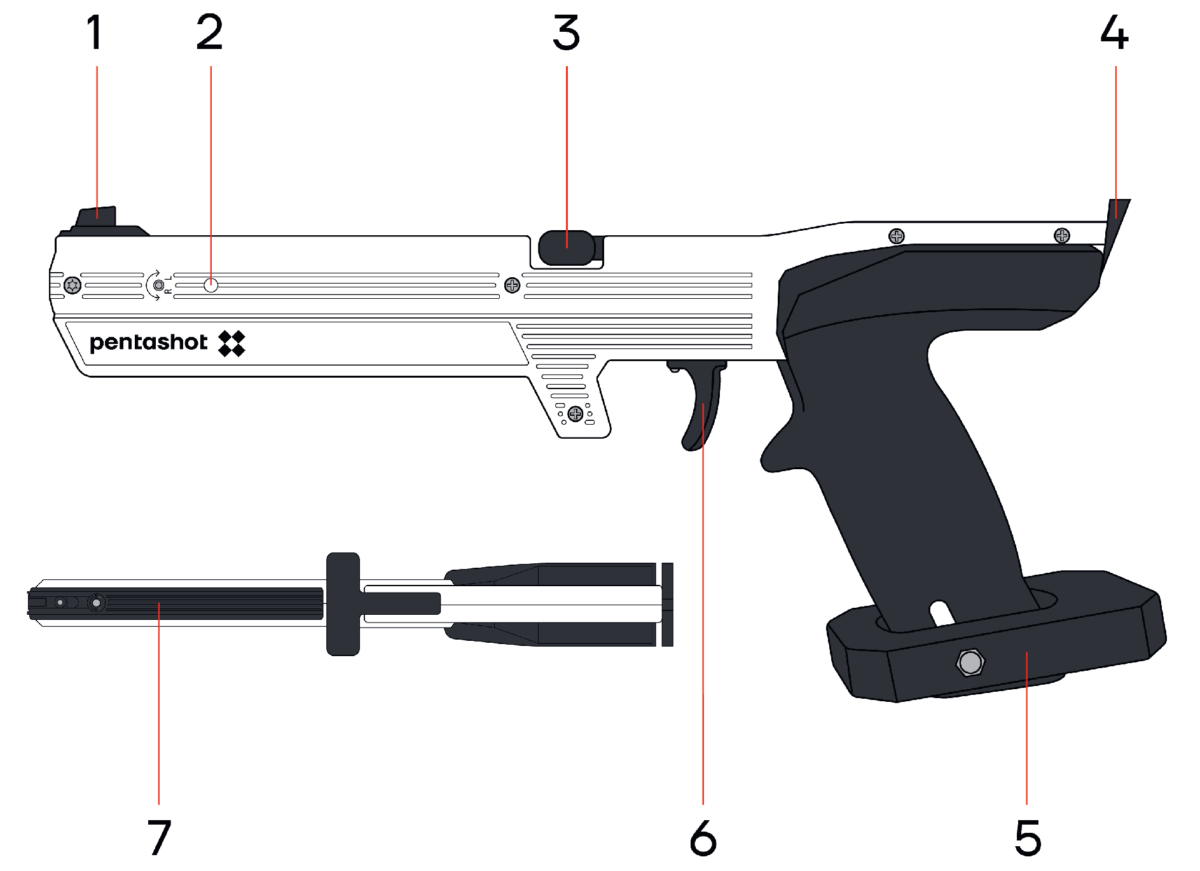
1 — Bead (front sights) integrated into the
battery cover
2 — Battery status LED
3 — Pull lever
4 — Rear sights
5 — Ämbidextrous grip
6 — Trigger
7 — Battery cover with integrated bead
PURPOSE
The GLS e.Start laser simulator is for use in instructional courses, training or competition in modern pentathlon. It is designed to shoot a laser beam activated by a trigger.
The GLS e.Start laser simulator is used like an FLP20-e laser module emitter with a 15.6 ms code. This code is completely compatible with the standards of the International Modern Pentathlon Union (UIPM).
Preparing the laser simulator for use
TURNING THE SIMULATOR ON
Pull the charging lever (3) to the maximum (about 35 degrees). This turns the laser simulator on while charging it for the fi rst shot. After start, the LED (2) on the left side of the simulator body will start to fl ash. The number of fl ashes indicates the battery status.
- 5 fl ashes – 100% battery charge
- 4 fl ashes – 75% battery charge
- 3 fl ashes – 50% battery charge
- 2 fl ashes – 25% battery charge
- 1 fl ash – battery is dead and needs replacement.
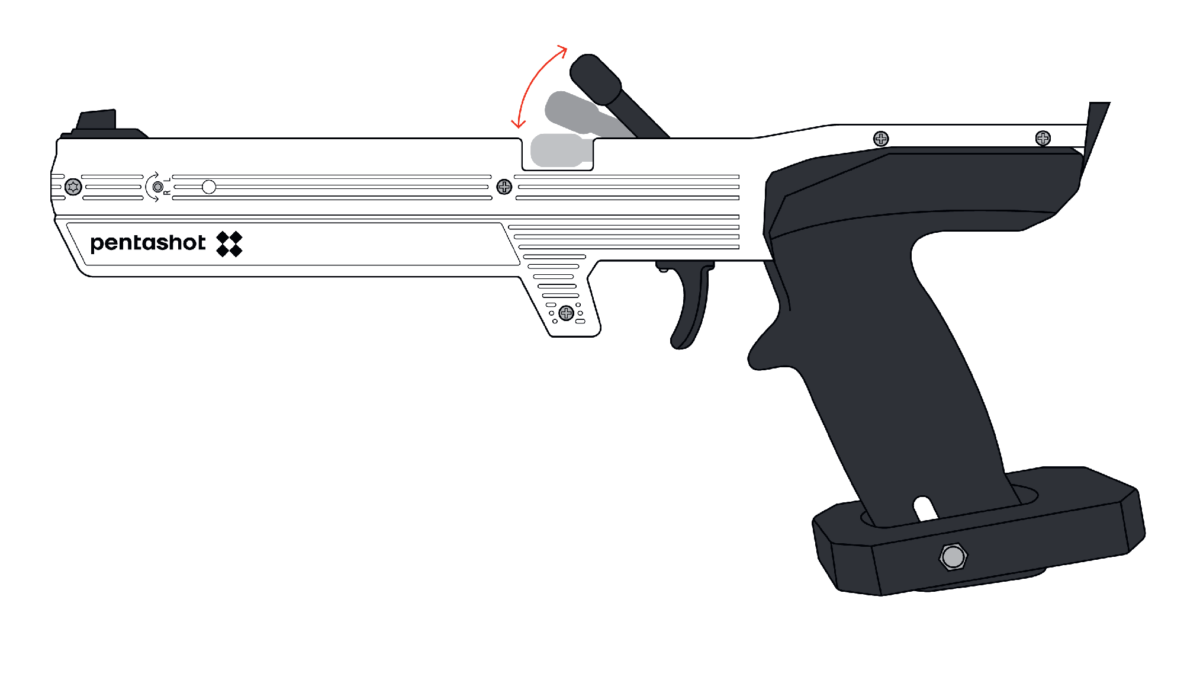
TURNING THE SIMULATOR OFF
The laser module shuts off about 30 minutes after the last light shot. If you need to turn it off right away, remove the battery from the simulator body.
ADJUSTING THE SIMULATOR SIGHTS (LASER DOT ALIGNMENT)
To adjust the sights of the simulator, aim at a white wall or white object 10 metres away and check the alignment of the red laser dots and sights. If necessary, use the adjustment screws to align the laser dots:
- Turning screw (8a) clockwise
- Turning screw (8a) counter-clockwise
- Turning screw (8b) clockwise
- Turning screw (8b) counter-clockwise
- moves the laser dot to the left
- moves the laser dot to the right
- moves the laser dot up
- moves the laser dot down
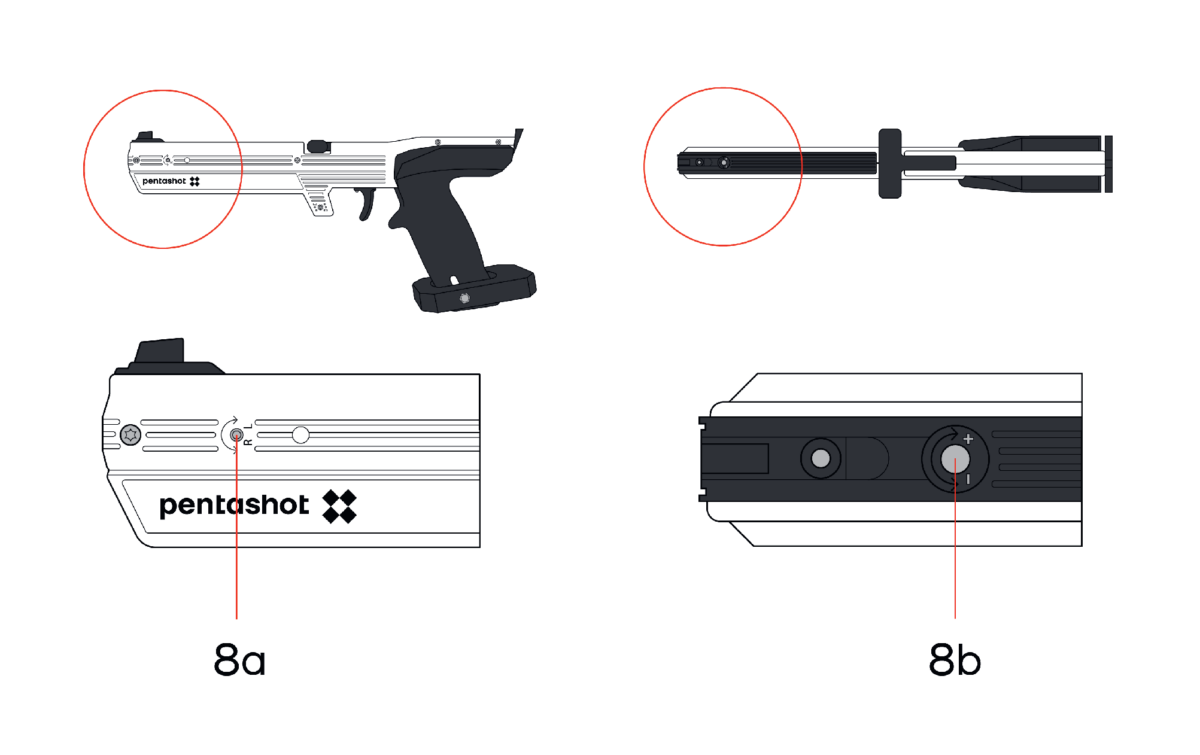
ADJUSTING THE SIMULATORS SIGHTS
IMPORTANT: The adjustment screw movements must be very small. One turn of an adjustment screw moves the laser dot about 20 cm at a distance of 10 m
TRIGGER POSITION SETTING
After loosening the screw (9), you can move the trigger position forward or back.

GRIP ADJUSTMENT
Use the included hex wrench to loosen the small screw at the bottom (10) of the simulator grip.
Set the new grip position and secure it using the small screw.
Use the included hex wrench to loosen the screw (12) in the grip boot. Then you can change the tilt of the boot. After adjusting the tilt of the boot, tighten the screw (12) again.
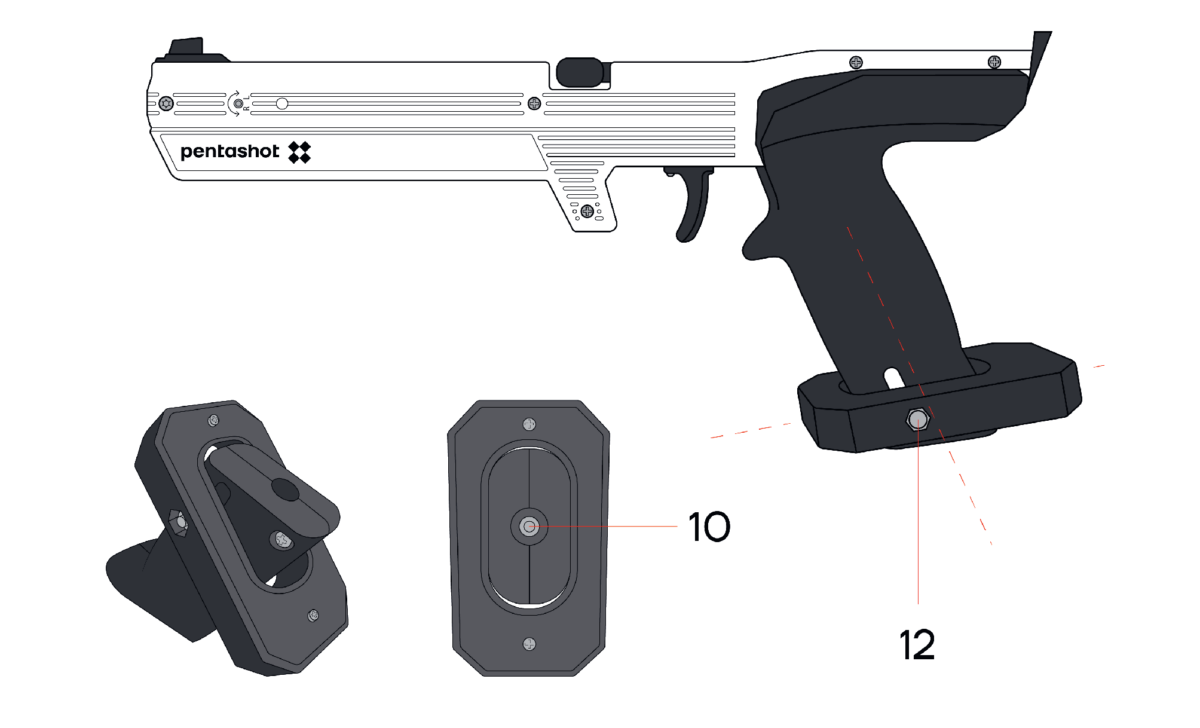
REPLACING THE BATTERY
If the LED signal light fl ashes once or constantly, replace the battery.
- Take out the screw (11) that also serves as the fastener for the battery cover (7) with integrated bead (1).
- Carefully remove the battery cover (7) completely.
- Remove the dead battery using the ribbon and insert a new battery (1.5 V type AAA).
- After replacing the battery, carefully put the battery cover back on and fasten it with the screw (11).
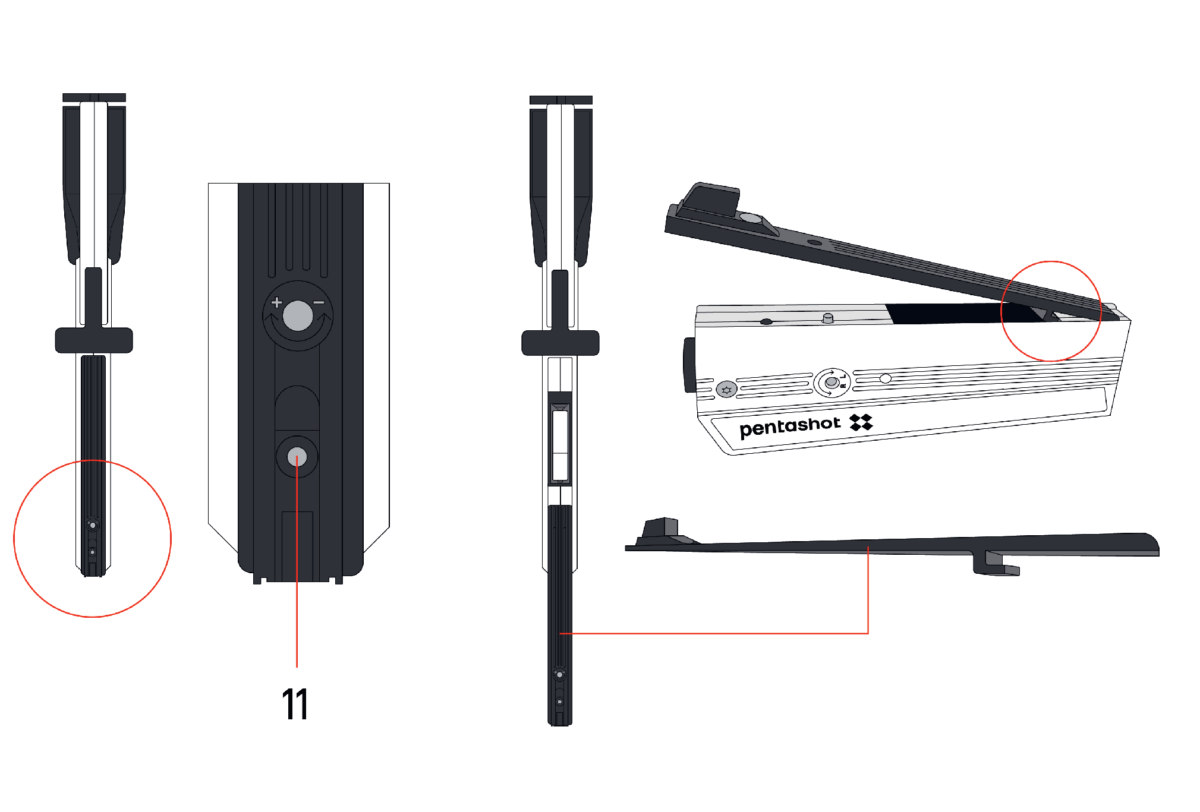
UPDATE FUNCTION
Only the manufacturer has access to the laser simulator software.
Technical data
| Dimensions | 355mm x 150mm x 50mm |
| Simulator type | Single-acting, laser |
| Weight | 670 g |
| Shooting distance | From 3 m to 10 m |
| Laser class | I. (per EN 60825-1:2014) |
| Laser class certifi cation | No. 1140735 (Electrotechnical Testing Institute, Czech Republic) |
| Laser module | FLPM20 |
| Laser signal | Laser signal UIPM 15.6 s |
| Wavelength | 650 nm |
| Diameter of laser beam | 4 mm ± 5 % / 10 m |
| Minimum laser power with low battery | 2,5 mW |
| Minimum laser power with new battery | 3,2 mW |
| Emitter power supply | 1.5V AAA alkaline battery |
| Number of illuminations per one AAA battery | 50,000 at 20°C |
| Operating temperature | From 10°C to 50°C |
| Update function | Software at manufacturer |
THE USER IS ALLOWED TO PERFORM ONLY THE FOLLOWING MAINTENANCE AND ADJUSTMENTS:
- adjusting the simulator sights (laser dots)
- adjusting the trigger position
- adjusting the grip angle
- replacing the battery
- replacing the simulator grip
It is forbidden to open or modify the laser simulator, other than to change the battery or grip. Only the manufacturer or an authorized person is to change the laser beam parameters. The owner of the simulator must confi rm his consent to the change in writing. The manufacturer will accept no liability for damages resulting from such a change.
Warranty
The warranty applies only to defects in materials and workmanship that can be shown to have appeared during the warranty period. Such defects can be repaired only by the manufacturer or an authorized service representative. The purchaser can make warranty claims to the manufacturer or authorized service representative, depending on the circumstances.
The warranty period begins on the day of purchase or delivery to the purchaser and remains valid for 24 months.
The following cases are expressly excluded from warranty repair:
- The product was not presented to the seller or manufacturer with proof of purchase.
- Wear as a result of product use or damage to the product (including damage caused by unqualifi ed installation, incorrect start-up, failure to observe the procedures specifi ed in the user manual, etc.).
- Damage to the product due to contamination, accidental or catastrophic events, or due to natural or outdoor events, such as storm, fi re, water, excessive heat or cold, penetration by liquids, etc.
- Physical damage to the product (caused by falling breakage, etc.) or damage caused during transport.
- Damage, unauthorized design changes, incorrect modifi cations to the product or other interventions into the product made by unauthorized people or service centres.
Storage
It is very important that the laser simulator be stored under the right conditions, so that it will stay reliable and in good condition. Always do the following:
- Before storing the simulator for an extended time, always remove the batteries. This prevents damage to the inside of the simulator if the batteries leak.
- Store the simulator in the original package (case) in a dry, dark location out of the reach of children.
- Do not place any heavy objects on the case, or objects that may leak fl uids.
- Protect the simulator from weather, including frost and humidity. The optimal storage temperature is +5°C to 30°C. The air humidity at the storage location must not exceed 60%. Do not store the simulator in a damp environment where there is a high risk of corrosion.
Replacement parts
The following replacement parts are available for the simulator:
- front sights
- grip
- weight
- trigger
You can order replacement parts by e-mailing to business@pentashot.eu or from PENTASHOT partners and sellers. You can fi nd a list of them at www.pentashot.eu.
Only the manufacturer or an authorized person is allowed to replace the main parts of the simulator (optics and electronics, including parts of the trigger mechanism).
Disposal
After the laser simulator’s useful life is over, it is not to be discarded with other household waste. Take it to a collection facility or have it disposed of by a specialized company authorized for the purpose.
Used batteries must not be thrown out with standard household waste. Take all used batteries to specialized collection locations.
